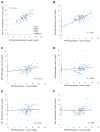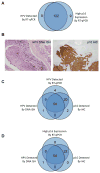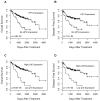A novel RT-PCR method for quantification of human papillomavirus transcripts in archived tissues and its application in oropharyngeal cancer prognosis
- PMID: 22821242
- PMCID: PMC3498587
- DOI: 10.1002/ijc.27739
A novel RT-PCR method for quantification of human papillomavirus transcripts in archived tissues and its application in oropharyngeal cancer prognosis
Abstract
Oropharyngeal squamous cell carcinoma (SCC) is strongly associated with human papillomavirus (HPV) infection, which is distinctively different from most other head and neck cancers. However, a robust quantitative reverse transcription PCR (RT-qPCR) method for comprehensive expression profiling of HPV genes in routinely fixed tissues has not been reported. To address this issue, we have established a new real-time RT-PCR method for the expression profiling of the E6 and E7 oncogenes from 13 high-risk HPV types. This method was validated in cervical cancer and by comparison with another HPV RNA detection method (in situ hybridization) in oropharyngeal tumors. In addition, the expression profiles of selected HPV-related human genes were also analyzed. HPV E6 and E7 expression profiles were then analyzed in 150 archived oropharyngeal SCC samples and compared with other variables and with patient outcomes. Our study showed that RT-qPCR and RNA in situ hybridization were 100% concordant in determining HPV status. HPV transcriptional activity was found in most oropharyngeal SCC (81.3%), a prevalence that is higher than in previous studies. Besides HPV16, three other HPV types were also detected, including 33, 35 and 18. Furthermore, HPV and p16 had essentially identical expression signatures, and both HPV and p16 were prognostic biomarkers for the prediction of disease outcome. Thus, p16 mRNA or protein expression signature is a sensitive and specific surrogate marker for HPV transcriptional activity (all genotypes combined).
Copyright © 2012 UICC.
Conflict of interest statement
H.W., X.M. and Y.L. are employees of Advanced Cell Diagnostics and hold stock options from the company. The remaining co-authors have no financial or other conflicts of interest to disclose.
Figures



Similar articles
-
Verrucous carcinomas of the head and neck, including those with associated squamous cell carcinoma, lack transcriptionally active high-risk human papillomavirus.Hum Pathol. 2013 Nov;44(11):2385-92. doi: 10.1016/j.humpath.2013.07.011. Epub 2013 Sep 24. Hum Pathol. 2013. PMID: 24071016
-
Detection of transcriptionally active high-risk HPV in patients with head and neck squamous cell carcinoma as visualized by a novel E6/E7 mRNA in situ hybridization method.Am J Surg Pathol. 2012 Dec;36(12):1874-82. doi: 10.1097/PAS.0b013e318265fb2b. Am J Surg Pathol. 2012. PMID: 23060353 Free PMC article.
-
Validation of methods for oropharyngeal cancer HPV status determination in US cooperative group trials.Am J Surg Pathol. 2012 Jul;36(7):945-54. doi: 10.1097/PAS.0b013e318253a2d1. Am J Surg Pathol. 2012. PMID: 22743284 Free PMC article.
-
Diagnostic accuracy of p16INK4a immunohistochemistry in oropharyngeal squamous cell carcinomas: A systematic review and meta-analysis.Int J Cancer. 2017 Mar 1;140(5):1186-1198. doi: 10.1002/ijc.30516. Epub 2016 Dec 2. Int J Cancer. 2017. PMID: 27859245
-
From HPV-positive towards HPV-driven oropharyngeal squamous cell carcinomas.Cancer Treat Rev. 2016 Jan;42:24-9. doi: 10.1016/j.ctrv.2015.10.009. Epub 2015 Oct 31. Cancer Treat Rev. 2016. PMID: 26547133 Review.
Cited by
-
Developing RT-LAMP assays for rapid diagnosis of SARS-CoV-2 in saliva.EBioMedicine. 2022 Jan;75:103736. doi: 10.1016/j.ebiom.2021.103736. Epub 2021 Dec 16. EBioMedicine. 2022. PMID: 34922321 Free PMC article.
-
Development of a Novel Mouse Model of Spontaneous High-Risk HPVE6/E7-Expressing Carcinoma in the Cervicovaginal Tract.Cancer Res. 2021 Sep 1;81(17):4560-4569. doi: 10.1158/0008-5472.CAN-21-0399. Epub 2021 Jul 2. Cancer Res. 2021. PMID: 34215618 Free PMC article.
-
Assessment of Human Papillomavirus Infection and Risk Factors in Egyptian Women With Breast Cancer.Breast Cancer (Auckl). 2021 Feb 25;15:1178223421996279. doi: 10.1177/1178223421996279. eCollection 2021. Breast Cancer (Auckl). 2021. PMID: 33716506 Free PMC article.
-
ARG1 mRNA Level Is a Promising Prognostic Marker in Head and Neck Squamous Cell Carcinomas.Diagnostics (Basel). 2021 Mar 31;11(4):628. doi: 10.3390/diagnostics11040628. Diagnostics (Basel). 2021. PMID: 33807310 Free PMC article.
-
Decreased local immune response and retained HPV gene expression during chemoradiotherapy are associated with treatment resistance and death from cervical cancer.Int J Cancer. 2020 Apr 1;146(7):2047-2058. doi: 10.1002/ijc.32793. Epub 2019 Dec 4. Int J Cancer. 2020. PMID: 31732968 Free PMC article.
References
-
- D’Souza G, Kreimer AR, Viscidi R, Pawlita M, Fakhry C, Koch WM, Westra WH, Gillison ML. Case-control study of human papillomavirus and oropharyngeal cancer. N Engl J Med. 2007;356:1944–1956. - PubMed
-
- Gillison ML, D’Souza G, Westra W, Sugar E, Xiao W, Begum S, Viscidi R. Distinct risk factor profiles for human papillomavirus type 16-positive and human papillomavirus type 16-negative head and neck cancers. J Natl Cancer Inst. 2008;100:407–420. - PubMed
-
- Ernster JA, Sciotto CG, O’Brien MM, Finch JL, Robinson LJ, Willson T, Mathews M. Rising incidence of oropharyngeal cancer and the role of oncogenic human papilloma virus. Laryngoscope. 2007;117:2115–2128. - PubMed
Publication types
MeSH terms
Substances
Grants and funding
LinkOut - more resources
Full Text Sources
Other Literature Sources
Research Materials
Miscellaneous

